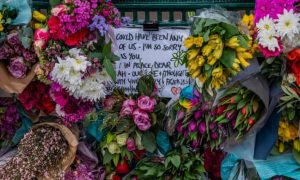
The N8 PRP Policing Innovation Forum 2022
VAWG in Public Places
21 June 2022 | Durham
The seventh annual N8 PRP Policing Innovation Forum was held in Durham on 21 June, on the theme of Violence against Women and Girls (VAWG) in Public Places. Despite the train strike, 92 people gathered – 61 in person, 31 online – to discuss the nature of harm, current campaigns, what justice looks like, and new practice-led interventions, led by chairs Ngaire Waine (Chief Supt., Merseyside Police) and Nicole Westmarland (Professor at Durham University and director of the Centre for Research into Violence and Abuse (CRiVA).
Representatives from academia, police, non-profits, and local and national government took part in panel and group discussions, sharing experience and best practice, identifying knowledge gaps, and finding new opportunities for collaboration.
Keynote: The Right Amount of Panic
How Traditional Safety Advice Harms Women
Introduction
Professor Nicole Westmarland welcomed participants to the forum. She noted that when she began at Durham 16 years ago, violence against women and girls was considered a niche interest, a ‘women’s problem’ that would never fill a room. Now however, the scale of the issue is more widely understood, and it’s accepted that everyone is responsible for ending misogynistic violence. She said that this is partly driven by high profile cases such as the murders of Sabina Nessa and Sarah Everard – herself a Durham University student a few years ago – and the forum is about those cases, and about the less serious but cumulatively damaging instances of VAWG in public spaces. Professor Westmarland said that while the harassment of women is too often a mundane, normalised part of day to day, and night to night, life, this does not need to be the case: there’s nothing innate or inevitable about misogynistic attitudes or behaviour, and in this forum we’ll hear about how we can change them.
Professor Westmarland the introduced activist, researcher, and author of the popular book The Right Amount of Panic, Dr Fiona Vera Gray.
‘They were more than what happened to them.’
Dr Fiona Vera-Gray (London Metropolitan University) began by talking about recent victims of men’s violence. The murders of Sabina Nessa, Sarah Everard, Aisling Murphy, Biba Henry, and Nicole Smallman have created a widespread momentum to end VAWG in public places, and we should start by saying ‘they were more than what happened to them.’ Dr Vera-Gray said those women would all have experienced male intrusion and violence since childhood, and made the case that for women in the UK, minimising the risk of male violence and intrusion is a normal part of life that shapes daily decision-making. However, if women talk about this ‘safety work’ or the fears that drive it, this is dismissed as paranoia, as such extreme violence is rare, and you’re safe as long as you ‘do the right things’.
‘A woman; any woman’
Dr Vera-Gray related this to the ‘Crime Paradox’, wherein women are more likely to fear crime although men are more likely to be victims of crime, and pointed out that women know they’re at risk simply for being a woman. The men who murdered Sabina, Sarah, Aisling, Biba and Nicole were all out looking for a woman to attack; they wanted to kill a woman, any woman. The fact that ‘it could have been any of us’ is a terrifying realisation. We need to resist the temptation to call this hysterical fear-mongering, and acknowledge that it is reality.

A note left at Sarah Everard’s memorial – ‘Could have been any of us’.
The other point about the crime paradox, Dr Vera-Gray argued, is that most of the intrusion and harassment women experience isn’t criminal. It is however experienced on a continuum, whereby apparently trivial incidents shade into and suggest others. In her research, women regularly site being told to ‘cheer up’ or ‘smile’ as ‘one of the worst ones’. It is a uniquely gendered instruction, with the insidious implication that your inner life doesn’t exist – nothing in your life could be as important as how you look to this man passing you in the street – a reminder that you can be seen at any point as ‘a woman, any woman’.
‘It’s inevitable, you’re paranoid’
Turning to traditional safety advice, Dr Vera-Gray said that women are uniquely addressed as being both the cause and solution to VAWG in public. Looking at campaigns, the cause of violence and harassment is located in women’s behaviour, so the solution is for women to change their behaviour – to watch their drinks, stay with friends, ‘be SMART’. So there’s the message that violence is inevitable so women have to change their behaviour. But women can never know if your decisions kept you safe because the absence of a predicted outcome is treated as proof that nothing was going to happen anyway. We can only know when it didn’t work, and then women are blamed for not doing ‘the right things’. The harm of traditional safety advice is it feeds into this impossible position – women are tasked with finding ‘the right amount of panic’, but no matter how skilled women are, we cannot prevent it all.
A new starting point
Dr Vera-Gray suggested that we should start with acknowledging the work that women do to keep themselves safe, and acknowledge that women are experienced, skilled, and capable in this because we’ve been practising since childhood. We need to validate the reality, and to acknowledge that women and girls feeling unsafe isn’t the problem – women and girls being unsafe is what we need to change.
Q&A
‘We need to do everything we can everywhere we can to make something that was once acceptable, unacceptable – and I think we can do that.’ – Fiona Vera Gray
Emily from Cleveland Police asked for examples of positive campaigns. Dr Vera-Gray pointed to those in the upcoming panel but clarified that she was asking for something that doesn’t exist yet, showing the constant presence of ‘safety work’. The aim is to shift the idea that individual instances are ‘trivial’ by showing the cumulative effect of harassment.
Professor Geetanjali Gangoli from Durham University asked how anti-VAWG campaigns reflect intersectional experiences, noting that for women of colour, intrusion is often a racialized encounter that may be experienced as gendered but is difficult to define as VAWG. Dr Vera-Gray agreed that campaigns should include these specific experiences, and cited the 2016 London Mayor’s campaign ‘I Just Want to be Free’ as a good example, noting the importance of working with and funding specialist advocacy groups.
Ngaire Waine from Merseyside Police asked if there was work being done on the specific experience of teenage girls and young women, as their experience is very different to that of relatively ‘invisible’ middle-aged women. Dr Vera-Gray suggested that rather than older women ‘aging out’ of the beauty standard or of heterosexual courtship, they were more skilled at preventing and disrupting these encounters, and this is why intrusive men target younger women. In terms of working with girls and younger women, Dr Vera-Gray advocated for an open agenda that gives girls chance to talk about their experiences and what they want to happen. She said that there are crisis centres and specialist groups working on this, and we need to fund them, rather than expecting teachers to have all of the expertise.
Finally, Nora Berghoff from University of Leeds asked whether campaigns could be effective in changing male perceptions and behaviour. Dr Vera-Gray said that one-off campaigns are always ineffective, and to counter the normalisation and encouragement boys get to harass women we need a long-term, multi-channel, society-wide approach – a 25 year project. She and Professor Westmarland agreed that if we have 25 years where boys grow up in a society invested in change, using the momentum we currently have, then we can end VAWG in our lifetime.
Panel: Behind the Scenes of Anti-Street Harassment Campaigns
Discussion with the people behind ‘Enough’, ‘That Guy’ and ‘Is This Okay?’
Professor Nicole Westmarland then hosted a panel discussion with three major recent campaigns against street harassment, featuring Police Scotland’s ‘That Guy’, GMCA’s ‘Is This Ok?’, and the Home Offices’ ‘Enough’ campaign.
Entitlement to Allyship
Adrian Searle, Head of Communications at Police Scotland, gave an overview of the research basis of the campaign which identified male sexual entitlement – rather than lack of understanding of consent – as the key issue to address. The video had a very high level of engagement, with over 6 million views worldwide, and the next stage is to help men to intervene with their peers.
Sarah Keaveny, Head of Communications at GMCA, discussed the challenges of creating a campaign with a lead time of two weeks when the Mayor of Greater Manchester, Andy Burnham, wanted an immediate response to the murder of Sarah Everard, pushing for a ‘watershed moment’ in changing the behaviour of men and boys. This included consulting with range of groups at every stage, which shaped the tone of the campaign. This included using a question, ‘Is this ok?’, and using a reading of that line that was resigned rather than visibly angry or upset. This was so viewers had space to draw their own conclusions and could more easily relate the specific events in the video to the experience of women more generally. The video has been shared over 5 million times on Twitter alone, with 44% of shares by men, and engagement has been overwhelmingly supportive. For the next stage, the campaign will move to schools and look into more one-to-one engagement with men and boys.
Finally, Ben Morse, Head of Campaigns Tackling Violence Against Women and Girls, Home Office, discussed the longer development process for ‘Enough’, which was also heavily focused on audience insight and specialist consultation with the stakeholder group. The research showed that focusing on gender norms triggered a defensive response, whereas using the concept of ‘allyship’ was far more positively received. There is a broad desire to create change, so focusing on practical acts of safe intervention was well received. Next, the campaign will look at challenging perpetrator attitudes more specifically. If you are interested in joining the stakeholder group, please contact Ben.
Q&A
Evaluating behavioural change
Bianca Fileborn from the University of Melbourne asked if there had been any evaluation in terms of impact on men’s attitudes and behaviour following the campaigns. For Sarah and Adrian, this evaluation was mostly focused on the scale and type of engagement in the short term. Both campaigns had a large proportion of supportive male engagement, which is a positive first step. Wider behavioural change is long term and difficult to connect to a specific campaign, but data is being gathered ahead of the next stage. Adrian added that the first stage of ‘That Guy’ is focused on self-reflection, with the next stage looking at intervention, and both are needed for behavioural change – the successful knife crime reduction campaign in Glasgow is a useful model for this. Ben said that robust evaluation had been built into planning, using pre- and post- campaign surveys and focus groups. This included using a questionnaire to identify those who held problematic views, and the campaign dose seem to have cut through with this group. For the next stage, they’re working to strengthen that model and improve those insights.
Consent in reports and the courts
Zoe commented on Adrian’s point that consent was understood but ignored, comparing this to the court system where it is the central point at contest. Adrian agreed this spoke to the need for wholesale cultural and societal change, where the effect of this behaviour is understood. Fiona Vera Gray added to this point that in court and investigations victims are asked to demonstrate what steps they took to show they did not consent, making it women’s responsibility, and having effectively a system of assumed consent.
Space for discomfort
Fiona Vera Gray asked if and when challenging the acceptability of harassment could include confronting men with their complicity in this behaviour, and asking them to sit with the discomfort of this reflection. Adrian and Sarah both discussed plans for more individual, guided conversations in the next stage of the campaigns, and the limitations of achieving this within a traditional communications model. Adrian also noted that positive models of behaviour are very important. Ben said that the campaign was guided by meeting the public where they’re at. A large section of society don’t think VAWG is acceptable and want a way to act, and if we can embed that lack of tolerance it lays the groundwork to a more guided conversation with perpetrators. Communications targeted at perpetrators is a new approach, and more needs to be done to understand its limitations and possibilities.
Nicole wrapped up the discussion by saying that men whose views had changed had an important role to play in showing that change can happen and how it happens, and are particularly well-placed to have those guided conversations. This is considered in Nicole’s forthcoming book with Stephen Burrell, Men’s Activism to End VAWG.
ECR poster exhibition
Dr Fiona Vera Gray and Dr Bianca Fileborn present the prize for best ECR poster
Dr Vera-Gray and Dr Fileborn praised all of the posters for their innovative work building an important knowledge and evidence base.
The judges said Nora Berghoff’s research on the role of imposter syndrome in shaping police behaviour posed a fascinating and innovation question, and Dusan Stankovic’s focus on rural crime in comparison to urban crime addressed an important and underserved area in criminology literature. They praised the innovation question and approach of Alisyha Dhir’s consideration of police discretion in the investigation of image-based abuse for young people, and noted Julia Guy’s impressive work on building the evidence base of context-specific forms of harassment on public transport in the north east.
Alishya Dhir was awarded the prize 6 books of her choosing from the criminology and criminal justice lists of Palgrave Macmillan and Bristol University Press – thank you to the publishers for their generosity.
Keynote: Achieving Justice on Street Harassment
Dr Bianca Fileborn presents research on victims’ perspectives on what ‘justice’ means for street harassment
For the afternoon keynote, Dr Bianca Fileborn gave a thought-provoking presentation, suggesting that ‘justice’ should not be thought of primarily in terms of criminal justice responses. Her research showed that for most experiences of VAWG in public what victims wanted was for the behaviour to be recognised and to be made unacceptable, for a focus of prevention through societal commitment to behavioural change, including support for bystander intervention, and reporting mechanisms that created an acknowledgement of the incident and visibility for the wider experience.
Breakout Session: ‘Risky Places’
Group discussions with leads of innovative, practice-led projects
Chief Supt. Ngaire Waine introduced the final session. Delegates were then given the opportunity to join one of six breakout sessions for a group discussion. Many of these projects included aspects of the type of justice Bianca had identified – there was Safer Transport Northumbria, which includes an app for reporting incidents; Choices, a school-based intervention, Safer Parks, a research project on how to make parks more welcoming for women and girls, and Knowsley’s SWAN programme, all consider behavioural change and preventative approaches. Durham Constabulary’s SWAN Hub provides a space for immediate refuge and access to ongoing support, and finally ‘NTE vs At-Home Drinking’ is a project researching how to mitigate the risks of alcohol-related violence that looks at the overlap between public and private spaces.
Balance, engagement, and evaluation
Following the discussion, each of the project leads summarised their session. Discussions had looked at the balance between accessibility, data-gathering for evaluation, and the implications of open-ended support; safety interventions in the context of supporting sociable and biodiverse spaces; mitigating the institutional barriers created by schools through near-peer mentoring; strengthening engagement with men and men’s groups; and intersectional approaches to harm reduction. All of the discussion leads said that they had found the session very helpful and were grateful for the input of the other participants.
Safer Transport Northumbria discussed how to generate useful data without creating obstacles to accessing the app. Currently, the app is only for signposting people to appropriate services, and doesn’t require any login details, but this makes meaningful assessment more difficult. Safer Parks shared the research finding that in terms of feelings of safety, environmental factors were secondary to interactions with people, and discussed the ‘temporality’ of parks – i.e. they are unusual for open, public spaces as they are only open in daylight hours.
Durham Hub raised with the group that while the hub had been established to tackle issues related to the safety of women and girls in the night time economy, in practice a wide range of people accessed the service for support with, eg, homelessness. Asked if the hub should turn people away, or make the hub a space for women only, the discussion group agreed that exclusion would be the wrong approach, but discussed managing the breadth of demand through solutions such as the design of the physical space, or having a mobile option such as a bus.
Choices discussed the limitations of school-based interventions due to the particular institutionalised nature of schools, and the possibilities of mitigating this through near-peer mentoring (i.e. mentoring by those ~18 months older). Knowsley Prevention had asked for other ideas for preventative communications work that could develop the programme, and discussed options like school theatre, hubs like the one in Durham, further engagement with men’s groups, and ways to incentivise bystander training for staff at local businesses – e.g. through accreditation they could publicise with a window sticker.
NTE and at-home drinking raised the point that women and girls’ experience of alcohol-related violence doesn’t compartmentalise neatly into public and domestic spaces, and asked how we reduce alcohol-related violence against women and girls in this broader context with preventative, public health approaches. The research project is looking for forces to participate and contribute force data, so those interested should contact Carly Lightowlers.
Wrap-Up
Ngaire Waine summarises the main points of the day
Commitment, investment, and learning
Firstly, violence towards and harassment of women and girls in public cannot continue to be normalised; we need to validate women’s reality both of the cumulative harm of this behaviour and the work that women do to keep themselves safe. We need a broad social commitment to and investment in change. In the discussion, we considered the importance of intersectional approaches and investing in the expertise and experience of specialist groups.
Secondly, we looked at campaigns that are doing this, challenging male sexual entitlement, showing the cumulative harm of harassment, and providing guidance for practical acts of support. The significance of consultation, and laying the foundations of widespread understanding and allyship in order to have more challenging conversations, creating the space for behavioural change with individual men.
The poster exhibition gave an insight into the innovative work creating the necessary knowledge base for action; then, we heard about what victims of public harassment and violence actually want. There are significant barriers to criminal justice, and the emphasis is on prevention, validation, and acknowledgement. The efficacy of bystander interventions in driving behavioural change was raised as a vital area of research, as there currently is not an evidence base in this area. As with other areas, sufficient funding for targeted interventions was raised as a major challenge.
Finally, we considered 6 projects that are trying different approaches to achieving this, and how they are looking to develop better engagement, evaluation, and knowledge to continue to improve this work – all of which depends on continued public investment to enable long-term change, driven by a social commitment to end violence against women and girls.
Ngaire then thanked all of the delegates, speakers, and organisers for an inspiring and motivating day.












